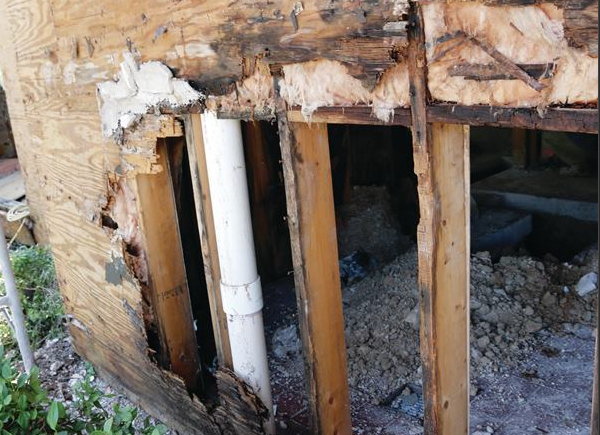–Roof pitch.
Shallow-pitch or flat roofs also contribute to the amount of water hitting a
wall during rainy, windy conditions. A steeper roof, on the other hand, can act
like an airfoil, pulling rain up over the roof and pushing it away from the
walls.

The textured surface on this housewrap, made by Tyvek, creates small vertical channels between the back of the cladding and the sheathing, allowing moisture to drain to the ground. It needs to be oriented properly when installed.
–Wall height. The
system that should be used is dependent on the location and design of the house
you’re building. It’s a matter of the walls’ exposure to water
infiltration—more exposure will require a higher level of protection. For
instance, a single-story house with a pitched roof and broad overhangs located
in an inland location that doesn’t receive much annual rainfall won’t need
nearly as much protection as a two-story building (which will have higher, more
exposed walls) with a flat roof located on a windy, rainy seacoast.
Best Bets
I like to use a housewrap that has a textured surface as the first defense for draining out moisture that infiltrates behind wall claddings. The small gap it creates between the back surface of the cladding and the sheathing allows water to drain away to the ground. Manufacturers use a variety of patterns and technologies to hold the siding away from the sheathing when it’s installed.
Dupont, the parent company of Tyvek, manufactures a family of small-gap housewraps. Two that I use are Tyvek Drainwrap and Commercial Wrap D. The main differences between them are that Commercial Wrap D is slightly tougher, and it has a longer UV-exposure time, so it will last longer if it’s going to be a while before you install siding. Both have a slight, almost crinkled corrugation, which when installed properly creates vertical channels for water to run out. Regardless of how tightly the siding is attached to the sheathing, Drainwrap and Commercial Wrap D create enough of a space between the back of the siding and the wall for water to drain away.

The plastic dots adhered to Benjamin Obdyke's Hydrogap housewrap hold the cladding off the sheathing and provide space for water to drain. This housewrap can be installed in any orientation.
Benjamin Obdyke’s Hydrogap housewrap has 1-mm–thick blue plastic oblong dots bonded to its surface. The thickness of the dots holds cladding away from the wall and creates a space for water to drain away. One of the things I like about Hydrogap is that it can be installed in any direction, even rolled out vertically, without its draining abilities being affected.
All the housewrap manufacturers sell proprietary tapes and flashing materials to use with their products. I stick with the manufacturers’ branded tapes that go with their housewraps and prefer ones with butyl adhesives. Tyvek’s StraightFlash and FlexWrap are among the best in the market.
Not all brands of housewrap are available everywhere in the U.S. If you can’t find one of the brands I prefer, look for a wrap with some kind of built-in air gap. Some housewraps can even be bought online. Benjamin Obdyke, for instance, will sell direct from its store website, and it offers free shipping.
This article originally appeared in THE JOURNAL OF LIGHT CONSTRUCTION, BUILDER’s sister publication.



